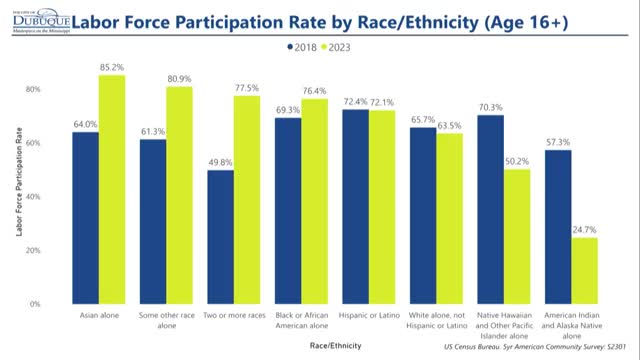Dubuque workforce analysis reveals racial disparities in labor participation and employment sectors
June 03, 2025 | Dubuque City, Dubuque County, Iowa
Thanks to Scribe from Workplace AI , all articles about Iowa are free for you to enjoy throughout 2025!

This article was created by AI using a video recording of the meeting. It summarizes the key points discussed, but for full details and context, please refer to the video of the full meeting. Link to Full Meeting
The analysis revealed that labor force participation has increased among Asian, Black, and multi-racial populations, while it has declined for other groups, particularly the Native Hawaiian and Pacific Islander communities. Notably, the American Indian and Alaska Native populations exhibited the lowest labor force participation and the highest unemployment rates, although these figures were accompanied by high margins of error, indicating a lack of confidence in the data.
The discussion also pointed out that while the unemployment rate for Black or African American individuals has risen, this coincides with an increase in labor force participation, suggesting that more individuals from this community are actively seeking employment but facing challenges in securing jobs. In contrast, the Native Hawaiian and Pacific Islander populations experienced a decline in labor force participation, which may reflect a disconnection from the workforce due to long-term unemployment.
Further analysis of employment by race and ethnicity across economic sectors revealed that Hispanic and non-white employees are disproportionately represented in low-paying jobs, comprising 12% of the workforce in these sectors compared to only 8.5% in high-paying sectors. This disparity underscores the ongoing challenges faced by racial minorities in accessing better-paying employment opportunities.
Gender dynamics in the labor force were also examined, showing a slight decline in male labor force participation while female participation has increased, leading to a more balanced workforce. However, women remain overrepresented in low-paying sectors, making up 63% of employees in these areas, while only 39% are found in high-paying sectors. Additionally, women continue to earn less than men across all economic sectors, highlighting persistent wage gaps.
The meeting concluded with key takeaways emphasizing the need for targeted strategies to address these disparities and promote equitable economic opportunities for all residents of Dubuque. As the council moves forward, the discussions will likely inform future initiatives aimed at reducing poverty and enhancing workforce participation among underrepresented groups.
Converted from City of Dubuque Council Work Session Equitable Poverty Reduction & Prevention Plan Update | June 2, 2025 meeting on June 03, 2025
Link to Full Meeting
Comments
View full meeting
This article is based on a recent meeting—watch the full video and explore the complete transcript for deeper insights into the discussion.
View full meeting
